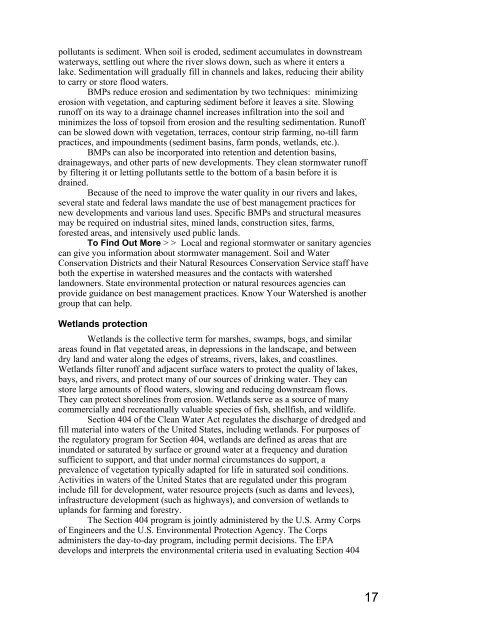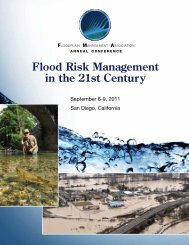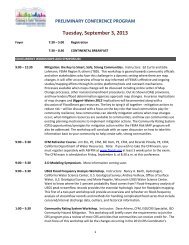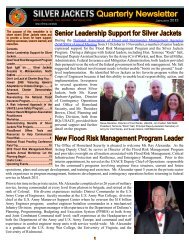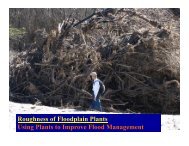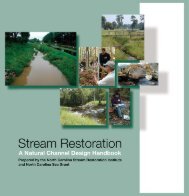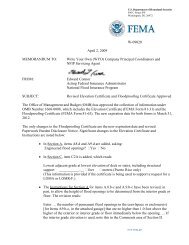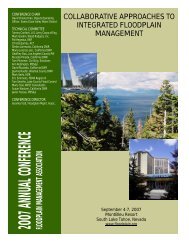Using Multi-Objective Management to Reduce Flood Losses in Your
Using Multi-Objective Management to Reduce Flood Losses in Your
Using Multi-Objective Management to Reduce Flood Losses in Your
Create successful ePaper yourself
Turn your PDF publications into a flip-book with our unique Google optimized e-Paper software.
pollutants is sediment. When soil is eroded, sediment accumulates <strong>in</strong> downstream<br />
waterways, settl<strong>in</strong>g out where the river slows down, such as where it enters a<br />
lake. Sedimentation will gradually fill <strong>in</strong> channels and lakes, reduc<strong>in</strong>g their ability<br />
<strong>to</strong> carry or s<strong>to</strong>re flood waters.<br />
BMPs reduce erosion and sedimentation by two techniques: m<strong>in</strong>imiz<strong>in</strong>g<br />
erosion with vegetation, and captur<strong>in</strong>g sediment before it leaves a site. Slow<strong>in</strong>g<br />
runoff on its way <strong>to</strong> a dra<strong>in</strong>age channel <strong>in</strong>creases <strong>in</strong>filtration <strong>in</strong><strong>to</strong> the soil and<br />
m<strong>in</strong>imizes the loss of <strong>to</strong>psoil from erosion and the result<strong>in</strong>g sedimentation. Runoff<br />
can be slowed down with vegetation, terraces, con<strong>to</strong>ur strip farm<strong>in</strong>g, no-till farm<br />
practices, and impoundments (sediment bas<strong>in</strong>s, farm ponds, wetlands, etc.).<br />
BMPs can also be <strong>in</strong>corporated <strong>in</strong><strong>to</strong> retention and detention bas<strong>in</strong>s,<br />
dra<strong>in</strong>ageways, and other parts of new developments. They clean s<strong>to</strong>rmwater runoff<br />
by filter<strong>in</strong>g it or lett<strong>in</strong>g pollutants settle <strong>to</strong> the bot<strong>to</strong>m of a bas<strong>in</strong> before it is<br />
dra<strong>in</strong>ed.<br />
Because of the need <strong>to</strong> improve the water quality <strong>in</strong> our rivers and lakes,<br />
several state and federal laws mandate the use of best management practices for<br />
new developments and various land uses. Specific BMPs and structural measures<br />
may be required on <strong>in</strong>dustrial sites, m<strong>in</strong>ed lands, construction sites, farms,<br />
forested areas, and <strong>in</strong>tensively used public lands.<br />
To F<strong>in</strong>d Out More > > Local and regional s<strong>to</strong>rmwater or sanitary agencies<br />
can give you <strong>in</strong>formation about s<strong>to</strong>rmwater management. Soil and Water<br />
Conservation Districts and their Natural Resources Conservation Service staff have<br />
both the expertise <strong>in</strong> watershed measures and the contacts with watershed<br />
landowners. State environmental protection or natural resources agencies can<br />
provide guidance on best management practices. Know <strong>Your</strong> Watershed is another<br />
group that can help.<br />
Wetlands protection<br />
Wetlands is the collective term for marshes, swamps, bogs, and similar<br />
areas found <strong>in</strong> flat vegetated areas, <strong>in</strong> depressions <strong>in</strong> the landscape, and between<br />
dry land and water along the edges of streams, rivers, lakes, and coastl<strong>in</strong>es.<br />
Wetlands filter runoff and adjacent surface waters <strong>to</strong> protect the quality of lakes,<br />
bays, and rivers, and protect many of our sources of dr<strong>in</strong>k<strong>in</strong>g water. They can<br />
s<strong>to</strong>re large amounts of flood waters, slow<strong>in</strong>g and reduc<strong>in</strong>g downstream flows.<br />
They can protect shorel<strong>in</strong>es from erosion. Wetlands serve as a source of many<br />
commercially and recreationally valuable species of fish, shellfish, and wildlife.<br />
Section 404 of the Clean Water Act regulates the discharge of dredged and<br />
fill material <strong>in</strong><strong>to</strong> waters of the United States, <strong>in</strong>clud<strong>in</strong>g wetlands. For purposes of<br />
the regula<strong>to</strong>ry program for Section 404, wetlands are def<strong>in</strong>ed as areas that are<br />
<strong>in</strong>undated or saturated by surface or ground water at a frequency and duration<br />
sufficient <strong>to</strong> support, and that under normal circumstances do support, a<br />
prevalence of vegetation typically adapted for life <strong>in</strong> saturated soil conditions.<br />
Activities <strong>in</strong> waters of the United States that are regulated under this program<br />
<strong>in</strong>clude fill for development, water resource projects (such as dams and levees),<br />
<strong>in</strong>frastructure development (such as highways), and conversion of wetlands <strong>to</strong><br />
uplands for farm<strong>in</strong>g and forestry.<br />
The Section 404 program is jo<strong>in</strong>tly adm<strong>in</strong>istered by the U.S. Army Corps<br />
of Eng<strong>in</strong>eers and the U.S. Environmental Protection Agency. The Corps<br />
adm<strong>in</strong>isters the day-<strong>to</strong>-day program, <strong>in</strong>clud<strong>in</strong>g permit decisions. The EPA<br />
develops and <strong>in</strong>terprets the environmental criteria used <strong>in</strong> evaluat<strong>in</strong>g Section 404<br />
17


